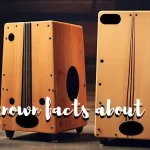Cajon – The History Of Cajon The Hand Drum
The history of Cajon (pronounced as “ka-hoon”) has been one of the most popular street percussion instruments since the late 19th century. Named after the Spanish word for “box”, the cajon became a key component in traditional Afro-Peruvian music. This amazing musical instrument originated to replace the drums of the African slaves in colonial Peru.
Cajon as a drum emerged in various cultures, countries, and over generations of time. The persisting traditions that influenced the development of music and instruments are typically traced back to Spanish colonies in Peru, Cuba, and other Caribbean nations. In the 19th century, drums across the region of Peru were forbidden for being a threat to the power of the masters. Undaunted and driven by the power of music, the slaves began using wooden boxes purposed to carry fruit or overturned drawers to play their rhythm upon. Later on, cajon was accepted as an integral part of the instruments used to play the vals criollo or the “creole waltz”. Now cajon is a beloved symbol of Peru’s national emblem, and the instrument is a must-have to perform traditional Peruvian folk music.
The history of cajon has a few more international twists. It played a similar role as an impromptu instrument for the marginalized masses in 20th-century Cuba. The new communist government also had its denigrators, and the protestors used loud music and drums in the rallies to attract larger crowds. Soon Fidel Castro stepped into the matter to suppress the potential source of political disobedience and banned street music and drums in order to control the rebellion. Cuban resisters insightfully turned the fruit boxes and other crude materials that can be harnessed to the rhythm of the music. By creating effective but inconspicuous drums they misled the police by appearing as loyal citizens sitting on top of fruit crates
Even though we name the Cuban, Peruvian, and flamenco styles in the context of modern-day cajon as if all these types evolved at the same time scale, the flamenco cajon was brought to the culture in the most recent times. The most contemporary development of cajon can be traced back to Paco de Lucia, the famous flamenco guitarist. While attending a party in his honor thrown at the Spanish embassy in Lima in the 1970s, de Lucia was introduced with cajon by a traditional Peruvian band. The flamenco style includes multiple rhythms played by the guitarists striking the body of the guitar. The appealing sound of cajon captivated Paco de Lucia and he asked his former Brazilian percussionist Ruben Danta to play the “Buleria” on the cajon, which is one of the rhythms used in flamenco. The impressive result made de Lucia return to Spain taking a cajon. The short staccato sounds that can be played on cajon make it a perfect fit for flamenco music because the sound traditionally relates to the footwork and hand claps or “palmas”. Soon it was assimilated into flamenco and adapted to Spanish music with the addition of guitar strings, bells, and other rattles mounted inside of the instrument to add more depth to the sound. Making its way to Spain was the first step of cajon on a journey toward worldwide popularity.
As we spoke before about African slaves inventing box drums by flipping over crates and boxes to replace drums, it also leaves so many doubts about the possibility of having an African connection to the contemporary cajon. The verdict of an African connection with cajon and other box drums is definitive but not in a very expected way. Most articles on this topic just say that African slaves of Peruvian colonies brought it to the new world but the evolution definitely began in Africa, traveled to the Americas and returned to Africa in a completely different form. During the 18th to early 19th century, box drums were introduced to the Gold Coast (present-day Ghana) by repatriating slaves who passes through west Africa on their way back to Cameroon.
The purest form of Peruvian cajon is a six-sided instrument, with a sound hole cut into the back panel. The front panel or Tapa is made from thin wood for its reverberance, leaving the other five sides to provide the structure. The sound is dry and the root tone is bass. Its primary role is as an accompaniment instrument. It traditionally didn’t need the bells and whistles, buzzes, and snares that have been added to it over time. Whereas, the Cuban cajon is usually held in the lap. it is pitched high (Quinto). Medium (salidor or tres dos) or low (tmba). With the sit-down bajo. The flamenco cajon is the one with guitar strings and loose corners that enable it to be a kit-in-a-box. it’s a bass drum, a snare and a seat all in one.
A modern cajon still follows most of the fundamental construction of the traditional Peruvian ones, especially in terms of dimensions and materials. Modern musicians, being masters, can’t help but tinker with the design to improvise and improve the instrument’s capabilities, though. New designs add repurposed piano and guitar strings and drum snare to add a nice “sizzle” or “snare” effect to the sound. The most recent modification to appear on modern-day cajon is tambourine cymbals. Many instrument players repurpose tambourine cymbals by posting a pair on the top left and right corners for superb “clacking” effects to their percussion. The cajon is one of the most popular, accessible, and visible box drums worldwide. New versions of cajon such as pocket cajon, bongo cajons, turbo cajon, etc, and accessories like pedals, seats, microphone pickups, etc, that are driving innovation in ways of playing, as well, are carving their paths into their being to elevate the form of cajon every year. Drums are these days being replaced by the cajon even in the bigger contests generating a new breed of drummers who keep the groove while spicing it up with texture


